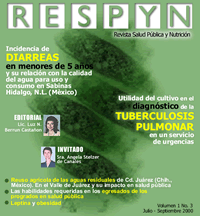Reuso agrícola de las aguas residuales de Cd. Juárez, (Chih., México). En el Valle de Juárez y su impacto en la salud publica
Abstract
El agua es uno de los más importantes restrictores deldesarrollo social y económico del hombre. Su escasez y
su contaminación amenazan aspectos fundamentales de
la seguridad humana, a saber:
• el equilibrio del medio acuático,
• la producción de alimentos,
• la salud pública, y
• la estabilidad social y política
En las regiones áridas y semi-áridas del mundo, el recurso hidráulico es cada vez más escaso por
lo que cualquier fuente de agua adquiere relevancia para la sobrevivencia y el desarrollo
socioeconómico
Downloads
References
Mará D y S. Cairncross 1990. Directrices para el uso sin riesgos de aguas residuales y excretas
en agricultura y acuicultura. España: OPS/PNUMA
Garza V 1994. La legislación ambiental en México en referencia a la generación y uso de aguas
residuales. Salud Fronteriza. 1994; VIII(1): 11-16
SEDESOL/INE1993. Informe de la situación general en materia de equilibrio ecológico y protección
al ambiente: 1991-1992. México: SEDESOL/INE
CNA. 1993. Aprovechamiento de aguas residuales en la agricultura: Situación actual en
México. Cuernavaca: Comisión Nacional del Agua
Idem.
Cifuentes E, U.J. Blumenthal, G. Ruiz Palacios and S. Bennett 1991.Health impact evaluation of
wastewater use in Mexico. Public Health Rev;19:243-50
Cifuentes E, H. Blumenthal, G. Ruiz Palacios, S. Bennett, M. Quigley, A. Peasey y H. Romero
Alvarez. 1993. Problemas de salud asociados al riego agrícola con agua residual en
México. Sal.Pub.Mex.; 35(6):614-619
Cifuentes, E. et. al. 1991, op.cit.
Fattal B. 1983. Prevalence of viral hepatitis and other enteric diseases in communities utilizing
wastewater in agriculture. Wat. Sc. and Tech. 15(5), pp45-58
Fattal B, Y. W.ax, M. Davies and H. Shuval 1986. Health risks associated with wastewater
irrigation: an epidemiological study. Am J Public Health;76(8): 977-9
Shuval H.I., P. Yekutiel and B. Fattal1985. Epidemiological evidence for helminth and cholera
transmission by vegetables irrigated with wastewater: Jerusalem a case of study. Wat.Sc. and Tech.;
(4-5): 433-442
Shuval HI, A. Adin, B. Fattal, E. Rawitz, P. Yekutiel 1986. Wastewater irrigation in developing
countries: Health effects and technical solutions. World Bank Tech.Paper 51. Integrated Resources
Recovery Series, UNDP Project Management Report 6. Washington, D.C.: The World Bank
CNA. 1993, op.cit.
Cifuentes E., H. Blumenthal, G. Ruiz Palacios, S. Bennett, y A. Peasey 1994. Escenario
epidemiológico del uso agrícola del agua residual: El Valle del Mezquital, México. Sal.Pub.Mex.;
(1):3-9
Idem
NOM-003-ECOL-1997. 1998. Que establece los límites máximos permisibles de
contaminantes para las aguas residuales tratadas que se reúsen en servicios al público. México:
Diario Oficial de la Federación.
Cifuentes, E., et. al. 1993, op.cit.
Shuval, H.I. et al. 1986, op.cit.
Hespanhol I. 1990. Guidelines and integrated measures for public health protection in agricultural
reuse systems. J.Water SRT-Aqua; 39(4): pp237-249
Mará, D. y S. Cairncross, 1990, op. cit.
Idem.
SSA Diagnóstico de salud de la Jurisdicción Sanitaria II de los Servicios Coordinados de Salud
Pública en el Estado de Chihuahua. Cd. Juárez: SSA; 1995
Idem.
Garza, V. 1994., op.cit.
NOM-001-ECOL-96. 1998. Que establece los límites máximos permisibles de contaminantes
en las descargas de aguas residuales y bienes nacionales. México: Diario Oficial de la Federación
NOM-002-ECOL-96. 1998. Que establece los límites máximos permisibles de contaminantes
en las descargas de aguas residuales a los sistemas de alcantarillado urbano o municipal. México:
Diario Oficial de la Federación
NOM-003-ECOL-1997, op.cit.
Downloads
Published
How to Cite
Issue
Section
License
The rights of the work belong to the author or authors, however, by sending it for publication in the Public Health and Nutrition Magazine of the Faculty of Public Health and Nutrition of the Autonomous University of Nuevo León, they grant the right for its first publication in between electronic, and possibly, in print to the Public Health and Nutrition Magazine. The license used is the Creative Commons attribution, which allows third parties to use what is published whenever the authorship of the work is mentioned and the first publication that is in the Public Health and Nutrition Magazine. Likewise, the author or authors will take into account that it will not be allowed to send the publication to any other journal, regardless of the format. The authors will be able to make other independent and additional contractual agreements for the non-exclusive distribution of the version of the article published in the Public Health and Nutrition Magazine (e.g., institutional repository or publication in a book) provided they clearly state that The work was published for the first time in the Public Health Magazine, Magazine of the Faculty of Public Health and Nutrition of the Autonomous University of Nuevo León.










